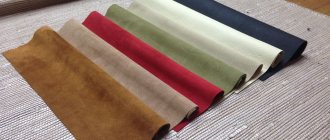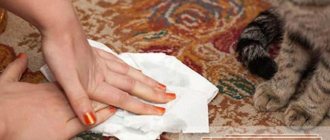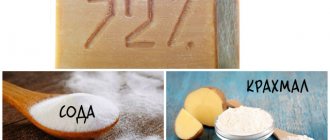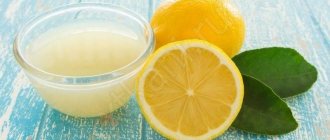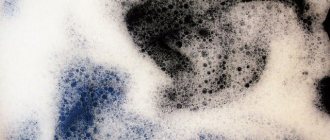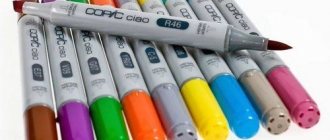Home page » Home and comfort » Wardrobe care
Author of the article
Svetlana Pavlikhina
Reading time: 7 minutes
AA
When performing a manicure at home, you can contaminate your clothes, leaving colored stains on them that are difficult to remove. It is impossible to wash off nail polish, but it can be easily removed with special substances that dissolve the product. It is important to select them taking into account the type of fabric and the complexity of contamination.
How to prepare a soiled item for washing
It is not recommended to immediately wash a damaged product: under the influence of the alkaline environment of soap and powder, the varnish coating hardens and eats into the fabric even more. After this, it will be impossible to remove the varnish (the blot from it).
Contaminated clothing is spread on a flat surface on absorbent paper or a cloth.
Apply a few drops of solvent (acetone, nail polish remover) to the blot and allow it to absorb.
How to remove dried varnish?
This, of course, is more difficult to do than to erase a fresh stain: the varnish is already thoroughly ingrained into the fibers of the fabric and does not want to part with them. However, use the following algorithm of actions and, perhaps, you will still be able to save the item.
- To begin, turn the item inside out. Take a piece of clean white cloth and fold it in several layers. If such fabric is not available, disposable paper towels will do. Place this lining strictly under the spot.
- Next, drop a drop of acetone or acetone-containing nail polish remover. For careful processing, use a syringe or pipette. Apply the selected product drop by drop over the entire surface of the stain until it disappears completely.
- Rinse the treated area with water. Replace with cloth or paper towels. Use a cotton pad soaked in solvent to blot off any remaining varnish. Repeat the procedure until the sponge stops staining.
- Now take the item, soak it in regular washing powder, and then wash it in the machine or by hand. Rinse thoroughly. Air dry to remove chemical odors.
Home Remedies
Simple means help remove accidentally planted varnish stains. They are always at hand: hydrogen peroxide, chemicals against flies, mosquitoes, hairspray, etc.
Hydrogen peroxide
An antiseptic at home is used to clean light-colored fabrics. A cloth or cotton pad is generously moistened with it and applied to the stain for 15–20 minutes.
During this time, the contamination disappears, but there is a possibility of discoloration of the canvas. This can be easily fixed by washing with powder.
Nail polish remover
Choose a product that does not contain essential and other oils: they leave greasy stains on the fabric. When cleaning colored fabrics, a liquid without acetone is suitable.
In order not to spoil the item, do a test before washing: moisten a cotton swab with a cleanser and treat an inconspicuous area of the clothing. If the color has not changed, you can wipe the varnish off the fabric from the front side.
Insect repellent
This is a gentle alternative to the solvent, acetone. Spray a little product onto the blot, apply a few more drops to an old toothbrush, a cotton swab, and wipe the stain with it until it disappears completely.
Then the substance must be washed off: rinse the fabric under a running stream. At the final stage, the clothes are completely washed with bleaching powder.
Hair fixation spray
This product effectively removes difficult stains. They are used to treat the contaminated area, after which the varnish needs to be cleaned with a soft brush, blotted with a napkin, and washed.
Acetone and gasoline
Solvents can easily clean off the most difficult paint stains. Acetone is carefully applied to the stubborn stain.
The fibers of the fabric are first stretched so that their binding is visible. Give the solvent time to absorb.
The blot is wiped with a sponge dipped in gasoline. There is no need to treat the surrounding area.
After all manipulations, the fabric is washed with powder. After using gasoline for cleaning purposes, the product is washed separately, with the addition of bleach and conditioner, so that the smell of the petroleum product does not transfer to other clothes.
After washing, acetone leaves complex, difficult-to-remove stains. This substance is not used for elegant, weekend, light-colored fabrics.
White Spirit
A universal solvent that easily copes with varnish stains. Disadvantage: it has a persistent, repulsive odor that can be removed after several washings and airing.
To wipe off varnish splashes, white spirit is applied to a cotton pad, applied to the dirty area for 1-2 minutes, then the item is washed with a good powder with the addition of bleach and conditioner.
Alcohol
For cleansing, take ammonia (1-2 drops), the same amount of vegetable oil and turpentine.
The components are mixed and applied pointwise to the stained area. The product is left for 10 minutes, then washed with bleach powder.
Glycerol
Residual, colored, varnish stains are removed with glycerin. The transparent liquid is heated by dipping the vial in hot water, applied with a pipette to the area of contamination, and left for half an hour.
After the substance is blotted with a napkin, the product is washed in the usual way.
We remove dirt from synthetics and delicate fabrics
Synthetic and delicate fabrics need a more careful choice of cleaner, because they can easily be hopelessly damaged by powerful solvents and unsuitable cleaners.
Here are possible options for soft influences:
- One good option is to use an acetone-free nail polish remover. Dampen the stain with it, leave for ten minutes and gently wipe with a cotton pad, being careful not to smear the varnish.
- Another good option is to use a mixture of oil (olive or sunflower), ammonia and turpentine, taken in a 1:1:1 ratio. Apply this homemade composition to the stained fabric and leave for ten minutes. The item should then be washed with the addition of dishwashing detergent.
- Hair fixation spray. Gently apply to a cotton pad and treat the stain, let it absorb, and clean thoroughly. The varnish particles should come off, which will help clean the stain.
Household chemicals
In addition to solvents and pharmaceutical preparations, household chemicals are used to remove cosmetic paint from clothes. They are no less effective and are always at hand.
Detergents
Gel or dishwashing liquid helps get rid of varnish stains on fabric. Pre-varnish on clothes is treated with acetone.
Dishwashing gel is dissolved in a small amount of warm water, a soap solution is applied to the stain, and washed off with a brush until it disappears completely.
Kitchen household chemicals, shampoos, shower gels, floor cleaners, tiles are suitable for washing.
How and with what to remove varnish from different types of fabric
The method is selected based on the type of matter. You can remove gel polish from clothes made from natural fabrics using aggressive agents and household chemicals, but only delicate methods can save a synthetic item. An alternative option is to use a repellent. The substance is suitable for removing dirt from any canvas.
Natural fabrics
Things made from this type of matter are dense and durable, so you can use stronger agents: acetone, hydrogen peroxide, gasoline. Any of these substances will help remove nail polish from clothes within 20 minutes. It needs to be applied to the contaminated area, after the specified time, sprinkle a little talcum powder on the damp area, and after half an hour wash the clothes in the usual way.
Synthetic and delicate fabrics
A mixture of ammonia, turpentine and olive oil can remove nail polish stains. You need to take each ingredient in equal proportions, make a paste of uniform consistency from them, apply it to the surface to be cleaned for 10 minutes. After the procedure, wash the item with powder or laundry soap. Helps remove dirt and glycerin. The cleaning process and time are the same as in the first method. Remove marks from delicate fabrics:
- chalk;
- powder;
- talc.
You need to sprinkle one of the products on the stained area, then blot the surface with a napkin, and rinse off the residue with water, the temperature of which should be +45... +50°C. The procedure takes 10 minutes.
White things
Bleach or hydrogen peroxide can help remove nail polish from light-colored clothes. One of the products should be applied to the stain, after 5-10 minutes, wash off the remaining substance with soapy water, then rinse the item in warm water. Gasoline and crushed chalk will help cope with the problem. The ingredients are taken in equal proportions, mixed until a homogeneous consistency, the resulting product is applied to the area of contamination and remains there until the liquid substance has completely evaporated. After the procedure, clean the product with a brush and wash it with the addition of bleach.
We recommend: How and with what to wash and remove berry stains from clothes and linen
From jeans
The material can withstand any chemical treatment, but when using certain preparations its color may become several shades lighter. Acetone will help remove stains from this type of fabric. The stain from nail polish remover will also disappear. The procedure is carried out in the same way as when working with other types of fabric.
Insect repellent will get rid of unnecessary marks in 3-5 minutes. It needs to be sprayed onto the contaminated area, held for the specified amount of time, then clean the treated area with a brush. The method will help remove varnish from cotton, linen, silk, and wool.
Removing varnish stains by fabric type
The method of cleaning the canvas depends on its type. Taking this factor into account, cleaning is carried out with minimal damage to the item.
Denim
Rough products made from durable fibers can easily withstand all types of cleaning agents. Varnish stains can be removed from denim with any solvent except chlorine.
This substance will corrode the paint and a white spot will appear at the treated area. To remove varnish from jeans, mix gasoline with turpentine or acetone.
The solution is applied to the blot with a cotton swab and left for half an hour to an hour .
Afterwards, the cotton pad is moistened in the solvent mixture again, and the stains are wiped until they are completely removed. If the varnish has dried and become crusty, first remove it with a hard object, being careful not to damage the fibers of the fabric.
An effective folk cleanser is a mixture of butter and washing powder. The ingredients are taken in equal quantities.
The resulting paste is applied to a fresh blot or tinder. After a few minutes, the dirt comes off, after which the jeans are washed with powder.
Synthetics
Not every solvent is suitable for such things. As soon as someone spills a varnish product on a synthetic fabric, the contamination is immediately removed with a cotton pad and then treated with a cleanser.
Popular experts recommend using hairspray. It does not leave stains or streaks and is suitable for synthetics. The substance is sprayed onto the stain, wiped, and after 15 minutes the procedure is repeated.
It is more difficult to clean varnish stains on synthetic fabric than on natural fabric.
Delicate fabrics
Not every product is suitable for washing such items; be especially careful when removing dirt from white clothes.
Take turpentine, ammonia, chalk in equal parts, prepare a thick mixture. It is applied to the blot, left for 1-2 hours, then blotted with a clean cloth soaked in acetone.
When the delicate fabric has been cleaned, the item is sent to the wash.
Hydrogen peroxide is suitable for thin, white fabrics. It lightens stains without destroying the structure of the canvas.
To remove cosmetic dye, you need to soak a cotton pad several times with peroxide and apply it to the stained area. After 20-30 minutes the stain will lighten, clothes can be washed after pre-soaking.
Natural fabrics
Products with a natural composition tolerate any cleaning agent well, but the paint also eats into them quickly and deeply. Acetone is applied pointwise to the stain, left to soak in, and after 15 minutes the procedure is repeated.
Then the stains are wiped off with a hard cloth, and the item is sent for washing.
Preparation
Nail polish stains should be removed immediately upon discovery. The main part of the composition that has not yet hardened is removed with cotton pads or a sponge, changing them as they become dirty. An old towel or piece of scrap fabric will do. The main thing is to remove spilled varnish as thoroughly as possible, without spreading the composition over a large area.
The next step is to determine what kind of fabric the soiled clothing is made of. If it is thick cotton or linen, it will be easier to get rid of the stain; wool or acetate silk will significantly complicate the task; it is better not to clean natural leather or suede yourself - such products are very “capricious”, you can hopelessly ruin the thing.
So, the soiled clothes are immediately removed, laid out on a flat, hard surface (table, chest of drawers) and the stain is removed, carefully wiping it with improvised means and trying not to smear it. You should place a napkin or towel in several layers under the item so as not to accidentally damage the surface of the furniture. Next, you need to get rid of the remaining varnish that has “eaten into” the fibers.
Preliminary actions:
- prepare compounds that may be useful;
- wear rubber gloves to protect your hands;
- provide ventilation;
- Try the selected removal method on the supplied piece of cloth or in an inconspicuous place.
For thin and colored fabrics, you should choose the most gentle compositions.
The fastest ways
Dried cosmetic paint can be quickly removed by scraping. In this case, act carefully, trying not to rub a hole in your favorite thing.
Fresh varnish stains can be easily removed with acetone. The material is stretched well, and acetone is dripped onto the paint smudges.
After 5 minutes the product dissolves and the clothes are cleaned.
Professional stain removers used in dry cleaners quickly clean contaminated fabric surfaces. The product diluted with water according to the instructions is applied to the dirt.
Action time: 5 minutes. After absorption, blot the stain with a napkin. If there are no marks, the product should not be washed.
Preparing to remove stains
The procedure should be approached responsibly and prepared in advance so as not to damage or spoil the fabric with the product used to remove the stain.
Important! If you immediately put the clothes in the washing machine after soiling and start washing, the varnish will be crushed and ingrained even deeper into the fibers of the fabric! It will not be possible to wash off nail polish, and it is impossible to rehabilitate the item after this, even by sending it to the dry cleaner.
Getting rid of stains takes place in several stages:
- Do not wait until the stain dries, try to blot it as quickly as possible, gently and carefully with a cotton pad or paper napkin. Remove as much polish as possible from the fabric.
- Use a cotton swab or toothpick to remove traces of varnish between the fibers of the fabric.
- Lay the clothes out on a horizontal surface and place a white cotton cloth under the stained area.
Advice! Before removing a varnish stain, make sure that the product used will not spoil or damage the material. To do this, test its effect on an inconspicuous area of clothing (on the wrong side, in the seam area), dropping a little product there and observing the reaction of the fabric.
It is much easier to remove stains from varnish from clothes made from natural materials: silk, linen, wool, cotton. This is explained by the fact that their fibers are less likely to react with chemicals compared to synthetic materials.
Acetone, nail polish remover (acetone-free), hydrogen peroxide, gasoline, and white spirit will help you remove nail polish.
How not to spoil something
The effect of all types of cleaners is checked from the inside out, in areas where no smudges or greasy stains will be visible. For white fabrics, do not use oil solutions, such as gasoline.
For colored and denim products, do not use chlorine bleach or hydrogen peroxide.
You can only remove dried pigment with a stiff brush or blade from rough canvases. This method is not suitable for delicate thin fabrics such as silk.
If the stain is old
If the stain has already dried well, you should try mechanical methods of removing varnish. Varnish is removed from textiles using sandpaper. A suitable solvent is then used.
There is another way with soap. To remove the stain you will need ordinary soap, preferably laundry soap. Apply soap to the sponge until foam forms. Apply to the contaminated area and leave for 30 minutes. Then the remaining varnish is removed. Stains may remain, which can be removed with turpentine and ammonia. To do this, mix the products in equal parts. After an hour, we wash our clothes. It is advisable to use butter instead of soap.
It is possible to remove varnish from an item using heat using an iron.
Place white paper on a flat surface, and place the item on top of it, dirt side down. Run a hot iron along the inside of the garment. You should change the paper when it gets dirty. Remaining varnish can be removed with acetone.
Common mistakes
Wanting to clean a favorite item from varnish stains, people make mistakes that lead to its damage. It is important to avoid mistakes so as not to throw your favorite thing in the trash.
What not to do:
- Apply solvents, generously covering the stain and the area around it.
- Use the cleanser without testing the underside.
- Rub fresh stains with soapy water.
- Use stiff brushes for thin, delicate fabrics.
- Use chlorine and acetone on colored canvases.
- Use oil-based solvents on white items.
- Soak the damaged item of clothing in powder or soap solution immediately after the varnish gets on it.
These are serious mistakes when removing stubborn varnish stains. Without doing them, the item can be preserved without defects or deformation for a long time.
Simple fabric types
Recent stains can be easily removed. To eliminate them, you need to arm yourself with cotton pads and acetone, and follow the instructions below:
- Gently blot any drops of varnish that have not yet been absorbed with a disc or napkin, and try to remove the dried residues from the fibers with a needle or toothpick.
- Fold several layers of cotton cloth or paper towel and place it under the stain.
- Place a cotton pad soaked in acetone on top. If you don't have acetone on hand, you can use turpentine or refined gasoline.
- Leave the item like this for a while, then gently rub the stained area with the disc. It is important to not allow the stain to dry until it is completely removed.
- Wash the item in the washing machine. It is advisable to use a special powder for stubborn stains.
It is not always possible to remove nail polish from clothes with acetone. Some items are made from delicate materials that can be damaged by harsh solvents. Before carrying out the procedure, be sure to apply a little acetone (or other product) to an inconspicuous area of clothing. If the fabric does not change its structure after some time, feel free to use the selected substance to combat stains.
Fluorescent and acetate fabrics easily deteriorate due to exposure to aggressive chemicals
We recommend: How to remove putty and concealer from clothes
In order to remove nail polish from white clothes , we recommend mixing gasoline with crushed chalk, applying the resulting paste to the dirt and leaving it for a while. Dried powder can be removed from the fabric with a regular toothbrush. After this, the item must be washed in a machine.
Remember that it is always much easier to clean fabric from fresh dirt. If the varnish has dried, performing any of the procedures described above once may not be enough.
If you were unable to remove nail polish from clothes using the proposed method, we suggest that you familiarize yourself with the list of substances used to combat such stains:
| Product name | Method of use |
| White Spirit | Soak a cotton pad or kitchen sponge in the product and apply to the contaminated area. After a couple of minutes, lightly rub the stained area. Wash your clothes completely |
| Denatured alcohol | Moisten the disc or sponge in alcohol, carry out similar actions, placing a fabric folded in several layers on the wrong side. Wash the product |
| Oxygen bleach | Apply a little solution to the stain, leave for 30-40 minutes, then rinse and wash the entire item |
| Hydrogen peroxide | Most often used for processing light-colored items. Soak a cotton pad or napkin in the solution and lightly rub the stained area. Change the fleece when it changes color. Repeat the procedure until the product is completely cleaned |
If after using the products there are stains on your clothes, gently wipe them with a cotton swab dipped in gasoline, and then sprinkle with talcum powder.
Never try to remove nail polish stains with vinegar or citric acid. This way you can further fix the stain or even make it brighter.
Methods for removing nail polish from clothes
In order not to spoil the material and get rid of contamination, you need to take into account some nuances:
- It is not recommended to wash the item with ordinary powder: the varnish will harden when it comes into contact with alkali and will become even more ingrained into the fabric;
- fresh drips are much easier to remove than old ones;
- chemicals that can remove stains should not be used on synthetic fabrics;
- Before cleaning, it is necessary to test the selected product on an inconspicuous area of clothing;
- work should be carried out wearing protective gloves;
- To prevent the stain from spreading under the influence of the solvent, it is necessary to wipe the stain from the edges to the center and periodically change the swab;
- After removing the stain, you should soak the item in soapy water for several hours.
The most common means of combating varnish stains are the following substances:
- petrol;
- nail polish remover used to clean nails;
- acetone;
- denatured alcohol.
Important! Products containing alcohol and acetone are toxic. It is necessary to work with them in ventilated areas.
Cleaning the brush from varnish
Any fresh stain is much easier to clean than an old one. Therefore, it is necessary to get rid of it before the varnish is completely dry. To do this, it is best to use a cotton pad, cotton swab or napkin. The stain should be treated with point movements from the periphery to the center so as not to increase its volume.
Varnish should be removed from the surface of the fabric before it dries.
The most common and effective means for removing varnish from natural fabrics is acetone. To use it, you must follow the following algorithm:
- We spread the stained item on the surface, placing a white cloth or paper napkin under it.
- Using a cotton pad soaked in acetone, treat the area with varnish residues.
- As the stain is absorbed, we replace the cotton wool device with a clean one and repeat the operation until the stain is removed.
- At the end of the procedure, wash the product in the usual way.
If you don't have acetone on hand, use nail polish remover.
Often, after using acetone, stains remain on the fabric. Refined gasoline will help remove them, which can be purchased at any hardware or hardware store. To use it, just follow the following procedure:
- We moisten a cotton pad with gasoline and wipe the area with solvent stains.
- Sprinkle the stain with crushed chalk (you can use baby powder or talcum powder) and leave the item for half an hour to absorb the product.
- At the end of the procedure, wash the product and dry it with air to remove the smell of gasoline.
Refined gasoline removes stains from fabric after using solvent
Acetone can successfully replace the white spirit solvent that many homeowners use. It is used to dilute oil paints, enamels and varnishes.
White products can be restored to their purity after varnish using the bleach you have at home. To do this you need:
- Apply bleach to stain.
- Leave for half an hour for the product to take effect.
- Wash the product in the usual way and dry it with access to fresh air to remove the smell of the substance.
Chlorine bleach can help fade nail polish stains on natural fabrics
Glycerin can deal with stains on light-colored clothing from shiny varnish containing aluminum powder. To use it, you must follow the following algorithm:
- Heat the bottle with glycerin in water to 40 degrees.
- Dip a cotton swab into the product and wipe the stain from the edge to the center.
- We wash the product in the usual way.
Glycerin will help if you need to wash off gray nail polish or one that contains particles of aluminum powder.
If a stain appears on a synthetic fabric product (or when you cannot determine its composition), use nail polish remover without acetone. The method for cleaning things is completely the same as when using acetone. If a greasy stain appears after using the product, wash the product with the addition of liquid dishwashing detergent.
We suggest you read: How to remove machine oil from jeans and other clothes using improvised methods? How to remove machine oil from clothes at home?
If the fabric is delicate (thin or lace), to remove the effects of a home manicure, use a homemade stain remover:
- We combine turpentine, ammonia and vegetable oil in equal quantities.
- Distribute the mixture over the contaminated area and wait 15 minutes.
- We remove the remaining composition with a napkin.
- We wash the product.
This method is also applicable for items made of synthetic fabrics.
One of the most effective means for removing various stains is turpentine.
To achieve these goals, you can also follow the following procedure:
- We drip (you can use a pipette) purified gasoline onto the contaminated area.
- Sprinkle the edges of the stain with crushed chalk, baby powder or talcum powder to prevent the product from spreading across the fabric.
- After 10–15 minutes, blot the treated area with a paper napkin without a pattern.
- We wash the product in the usual way and dry it with access to fresh air so that the smell of gasoline disappears.
To remove old varnish from an item, you will have to be patient and spend more time. First of all, it is necessary to remove the dried particles. If the stained item is made of thick material, use fine sandpaper or a nail file. Rub the stained area to remove the top layer of varnish.
If the fabric from which the product is made is delicate, then:
- Place a sheet of white paper on the item to be cleaned, dirty side down, with which the varnish stain should be in contact.
- Iron the product with a heated iron from the wrong side (a layer of varnish will be imprinted on the paper).
- We replace the sheet with a clean one and repeat the procedure until the paint is removed.
- After this, we use one of the above methods for cleaning the product from varnish (depending on the type of fabric).
When applying various designs to your nails, you need special manicure brushes. After each use, they must be cleaned, otherwise the varnish will dry out and the device will become unusable.
Manicure brushes must be cleaned after each use.
Alcohol is considered an effective tool for cleaning brushes. The way to use it is simple:
- Apply the product to a sponge or napkin and clean the brush.
- Rinse the device with a small amount of alcohol poured into a container.
- Dry the brush with a dry sponge or napkin.
You can use another method of cleaning the brush:
- On the surface of the saucer, mix a few drops of liquid dishwashing detergent and vegetable oil in equal quantities.
- Clean the brush in the resulting liquid.
- Rinse it in a container with warm water, to which a few drops of liquid dishwashing detergent have been added.
- Rinse the brush again with clean water.
- Dry with a dry sponge or napkin.
Removing stains using household chemicals
Every housewife knows that stubborn stains are much more difficult to remove, so if it happens and varnish gets on your clothes, it’s better not to waste time and quickly take action. First of all, you should remove excess with a napkin.
Carefully wipe off the top layer of varnish, after which only what has been absorbed into the fibers of the fabric will remain. The next step is to lay things out on a table or other hard surface.
To avoid other unpleasant situations, you should place a clean piece of cloth or napkin under the stain from the inside out. The cleaning process itself can take place in different ways, depending on what you use for this.
Acetone
This is probably one of the most effective nail polish removers.
Initially, drop acetone onto the stained area so that the fabric is saturated. Next, apply nail polish remover to a cotton pad or just a piece of cotton wool and gently work the stained area until the stain disappears completely.
After this, you need to wash the item, first rinse the area of contamination in a soapy solution, and only after that put it in the washing machine. Be careful to check the acetate content on the label before processing the fabric.
Nylon, artificial leather and silk acetate are best cleaned in another way.
Other nail polish removers without acetone
As you know, nail polish remover can be based on acetone or oils; now we are talking about the second option.
The process itself is no different from the previous method, the only difference is that it is suitable for artificial and synthetic fabric.
Be careful, the liquid must be transparent, otherwise you will have to remove the stain from it too. It is very important that after you have removed the varnish from the product, treat the area with dishwashing detergent so that there is no greasy stain left on the fabric.
Cleaners
Now on store shelves you can find a lot of chemicals for such cases, and if you rely on their help, you need to carefully prepare for the preparation process. First of all, remove excess varnish; if it is dry, scrape it off carefully with a knife.
Apply and foam the chosen product.
Try not to rub it into the surface. After applying the product, wait about 20-30 minutes, then send the item to the wash.
Glycerol
This product is perfectly used in many fields of activity, from medicine to construction.
In getting rid of unwanted stains, glycerin will also play the right role.
Simply apply a small amount of product to the stain using a cotton swab.
Thoroughly wash the contaminated item in soapy water and dry it.
After this there will be no stain.
Petrol
Initially, blot the stained area well with gasoline and wait 10-15 minutes. After this, wipe the area with a napkin and send it to wash. But it is best to wash things after such treatment separately from other clothes, so as not to convey the smell of gasoline.
It’s better to get rid of the smell from the product itself using a balcony; we just let it dry and wait until it dissipates.
White spirit: bleach
Many housewives know about this product and its incredible properties.
It will be no less effective in cleaning clothes.
First, soak a cotton pad well in white spirit and place it on the stain.
After that, wait about 15 minutes, wipe the stain and wash the product in the machine.
Hair fixation spray
Everything here is also quite simple, but very effective. Spray the stain and rub thoroughly with a soft lint or towel. After this, leave to dry.
Denatured alcohol
This method will most effectively get rid of the stain you just applied.
Place a clean rag or napkin under the back of the fabric.
Soak a cotton swab in alcohol and begin to carefully treat the area of contamination. To avoid smearing the varnish on the fabric, you need to gradually move from the edge to the middle of the stain.
Working with textiles: removing gel polish from clothes
According to the results of sociological research, Italians use dry cleaning services most actively. Residents of Italy rightly believe that everyone should mind their own business.
After all, dolce vita is something to be enjoyed whenever possible, and there is no need to limit these opportunities.
In Russia, it is customary to wash, clean and iron clothes at home. With all the unique knowledge that we possess regarding the household, it is not always possible to maintain composure.
As, for example, when gel polish gets on clothes. A random drop can disarm even those who have seen everything.
Indeed, removing gel polish from clothes is not easy. When washing in the traditional way - with powder, gel or soap - the stained area spreads into a stain, and the problem turns from unpleasant, but solvable, into a natural disaster.
Let's figure out how to remove varnish from fabric so that your favorite item remains in your wardrobe.
We start working on the error right away, rather than putting it off in a long box, from which the item is guaranteed to be scrapped.
Before cleaning, we test the product on an inconspicuous area - for example, an internal seam, a fold of a product, or a flap included with the fabric.
Acetone
The first weapon against varnish on clothes is industrial, medical or cosmetic (IMC) acetone. Suitable for removing nail polish and gel polish from dense natural materials - for example, cotton or linen.
- Place the stained fabric on a paper towel or thick light cotton napkin with the stain down and the wrong side up.
- Transfer the stain to a napkin/towel, blotting it from the wrong side with a cotton pad soaked in acetone.
- We change the napkin to a clean one and repeat the procedure again and again - until stains stop imprinting on it.
- We additionally treat very light or white fabrics with peroxide to remove any remaining color pigment.
- We send the item to the wash using traditional means for problematic items - powder or gel with a stain removal function.
Petrol
Thin, delicate or synthetic items that come into contact with acetone often become unusable. We don’t take risks, but take gasoline in our hands and act according to the above instructions.
- Fabric - on a napkin.
- Use a cotton pad on top.
- Apply until the gel polish is completely dissolved.
- Wash off greasy gasoline stains with dishwashing liquid.
- The item goes into the washing machine.
Hair fixation spray
We do not touch particularly sensitive fabrics - natural silk, fine synthetics, brightly colored fabrics - with acetone, non-acetone, or gasoline.
- We take hairspray and, trusting in its omnipotence, spray it on a cotton pad and try to wipe off the hairspray.
- In the process of rubbing the varnish with varnish, the molecules separate and the stain dissolves. Even if nothing happens, the fabric is guaranteed not to discolor or deteriorate.
- Washing in warm soapy water also completes the cycle in this case.
What if it's dry?
You can try alcohol, white spirit, and turpentine as gentle solvents. In the “raw” they work with a bang.
What to do with gel polish that has dried on a T-shirt or pant leg? Anything can happen in life. It’s not always possible to do everything at once.
- We place the fabric on the paper with the stain down and move the iron over it, transferring the varnish to the “gasket”.
- We clean the residues with solvent.
- If the material does not tolerate high temperatures, we must be patient and dissolve the stain molecule by molecule. Patience and work, you know.
Acetone
The easiest and most effective way to remove traces is acetone. It is likely to damage synthetic fabrics, so it is recommended to use it if you have stained something made from natural material.
Place a white rag under the stained area, rolling it several times. Pour a small amount of acetone onto a cotton pad or directly onto the stain and gently rub the area.
If there are stains left on the fabric after acetone, treat them with a sponge or cotton wool soaked in gasoline. After this, sprinkle a little dry baby powder on top, and after an hour, try to remove any remaining traces of dirt with a regular detergent.



